Have you got a killer SaaS idea, but can’t think how to grow your idea into a viable business?
Many startup founders have really cool ideas, but they simply don’t know how to manifest their idea into a viable business.
It’s a multi-pronged process, but one of the essential steps is getting you SaaS OKRs in order. In a nutshell, they’re the guiding stars for where you hope to take your organization and what your major goals are?
But where do you start? In this article, we’ll take you through examples of major OKRs you should be striving for, as well as how to break these broader OKRs down into achievable milestones.
But before we get into the nitty gritty, let’s do some basic SaaS OKR 101.
What are SaaS OKRs?
OKR stands for Objectives and Key Results—it's all about setting ambitious goals and nailing them with precision!
Designed for companies, teams, and individuals, OKRs break down big strategies into achievable chunks. Whether you're boosting performance or ramping up productivity, OKRs keep you on track with measurable outcomes.
In his book Measure What Matters, John Doer, characterizes OKRs as such:
“The OKR framework cultivates the madness, the chemistry contained inside. It gives us an environment for risk, for trust, where failing is not a fireable offense- you know, a safe place to be yourself.”
Climbing a mountain can can be pretty scary if you’re just thinking about getting to the top, but if you break it down into smaller, but significant milestones, it suddenly seems more scalable and safer. That’s the gift that OKRs can give you. The sooner you think about your larger goal as a collection of smaller significant milestones, the sooner you’ll be taking significant steps to your goal.
What does success with SaaS OKRs look like?
Doer defined success with OKRs under the acronym FACTs ( Focus, Alignment, Commitment, Tracking, Stretching).
Focus
When you have a clear idea of what your goals are, your work becomes more purposeful and time is used more efficiently. If you're able to bring focus to your day to day operations, you can cut out the fluff, and make sure every decision you make is driving you toward achieving growth.
Alignment
Alignment smashes those silos preventing your team from working as a cohesive whole. Unite your team behind your company's vision to ensure that every success for individual team impacts the overall success of your org.
Commitment
OKRs consolidate the commitment your team need to make to achieve long term success. Without those milestones, it's very difficult for your team to know what exactly they're committing to and stay motivated.
Tracking
SaaS orgs have to be able to pivot when things are going wrong and iterate on things that are going right. OKRs allow your team to keep tabs on these successes and shortcomings. That way you can expand on the positves and make adjustments where needed.
Stretching
Get your org into that all-important growth mindset by stretching those goals a little beyond what you may think your capable of. That way, even if you fall a little short of your goals, you'r e still going to be enjoying considerable success.
Why are SaaS OKRs important for SaaS companies
Once your product idea becomes a fledgling business, the drive to become profitable becomes a pressing issue. It’s a considerable mountain to climb, and it can be overwhelming, especially for those with limited experience in actually growing and sustaining their business. OKRs, then, are the small significant milestones that you’ll be aiming for on your journey to profitability, and ultimately, expansion at an enterprise level.
OKRs, like any strategic framework, is no silver bullet for organizational excellence. However, when applied correctly, they can be a valuable tool to empower your team to do their best work.
Marielle Velander, Senior Product & Technology Operations Analyst at N26
OKRs empower SaaS companies to prioritize innovation, enhance product offerings through iterative improvements based on customer feedback, and optimize essential metrics for balanced growth and profitability.
We’ve condensed these benefits down into this nifty infographic:
Now that we’ve got the whats and whys out of the way, let’s get in to the actionable strategies that should drive your OKRs.
How to implement SaaS OKRs in 5 steps
1. Introduce them to your team
Before rolling out any kind of new framework, communication is key.
Explain the concept of OKRs to your team, and what you hope to achieve by implementing them. Outline the timelines you plan to use to measure their success (monthly, quarterly) and most importantly discuss the procedures around deliverables, progress checks and what to do if any problems arise.
2. Define OKRs
Define your specific objectives by asking yourself three simple questions.
- Where am I now?
- Where do I want to go?
- How do I get there?
Your answers will form the outline of the OKRs for every team member within your given timeframe. For example, your objective might be to reach out to 30 potential new clients over the next month, taking meetings with at least 15 within two months and sealing the deal with 10 over the next quarter.
Once the rest of your team are aware of your objectives, they can break them down into bite-sized tasks or relevant metrics to help the company achieve that goal, whether that's by adding features to entice a certain type of client or resolving customer issues for better feedback.
3. Regular check ins
Discussing OKRs at the start and the end of each cycle just isn’t enough.
Regular check-ins to see how objectives are progressing and whether individuals are on track to meet their targets are vital to everyone achieving their goals.
Schedule weekly or bi-weekly one-on-ones with team leads to see if you can provide guidance or assistance to help them reach their target. Keeping on track ensures you have enough time to achieve what you set out to without having to scramble for time as the quarter comes to an end.
4. Measure your OKRs
You can measure OKRs by implementing a scoring system.
California's Chief Innovation Officer, Rick Klau recommends scoring key results between 0.0 to 1.0, however, 0% to 100% are perfectly acceptable too.
To calculate the score, we divide the target set by the result, so for example if sales had a target of calling 1,000 leads but only managed to call 400, their score would be 0.4, if they called 800, then the score is 0.8. Once you have the score, you can grade the key result using this grading system as a guide.

5. Establish feedback loops
It will take time for you and your team to get used to the process of OKRs, and you might not have all of the right metrics in place at the very start, but once you’ve completed a few cycles you’ll get a better feel for realistic timelines and how long certain processes actually take.
It’s so common to underestimate the time it takes others to complete certain tasks or overestimate how much users are going to love a certain feature, but that’s the beauty of OKRs, even if they're not quite met, there’s a goldmine of valuable information about your organization to be mined from the results. On the flipside, you might find that a certain set of measures aligns perfectly with your business goals, and you can really hone in those metrics and add them to your grading system accordingly.
How to report on your OKRs
Once you’ve set your OKRs and have your measurable results, you’ll need to record and report them.
Here’s a really simple, low maintenance table we pinched from Product Marketing Alliance. It includes all of the top-line information you need to document.
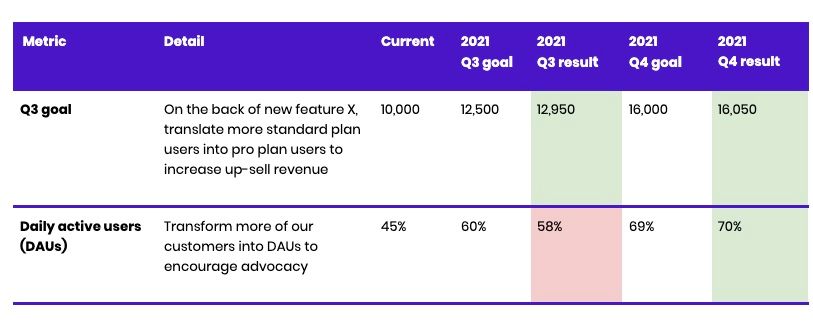
10 best OKR examples for SaaS companies
Building a sustainable growth engine
At a time when SaaS startups are struggling to achieve that sweet investor funding, startups need to be focused on growing sustainably. That means they need to be able to make the most of their scant resources to grow, while being mindful of expense.
Companies rely on organic search in particular, as it's relatively inexpensive compared to acquiring paid ads. Organic search and SEO page optimization gets eyes on your organization, generates leads, and if all goes well, leads to customer acquisition. The milestones are never going to be exactly the same for any two companies, but here are some of the milestones you should be looking at:
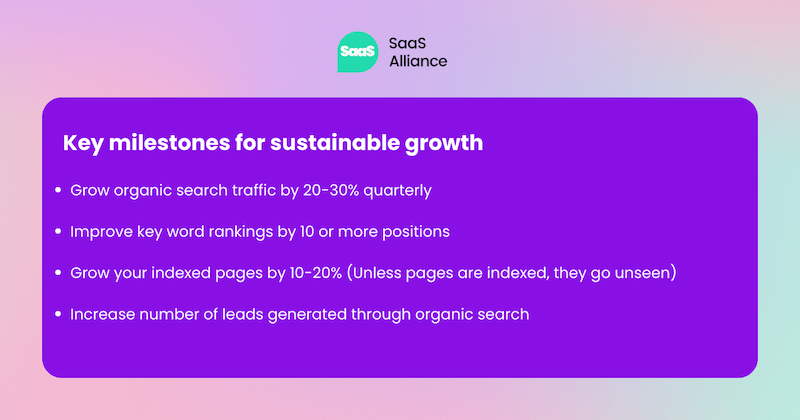
In order to achieve organic search success, consider a thought leadership strategy. Put out on content on your blog that offers solutions to your target market problems rather than aggressively trying to push your product. With this strategy, you’ll establish your company as an authority in the industry, establishing that foundation of trust that translates to customer acquisition.
Establish a growth flywheel
SaaS companies need to grow fast, and for that to happen you need to get to grips with the growth flywheel. A growth flywheel is essentially when the different aspects of growthyou manage to achieve over time eventually gain their own momentum and feed into each other. In a nutshell, the growth you’ve achieved on one aspect of your business elsewhere positively impacts other important growth efforts, leading to long term sustainable growth.
Here are the OKRs you need to be looking at to establish your flywheel:
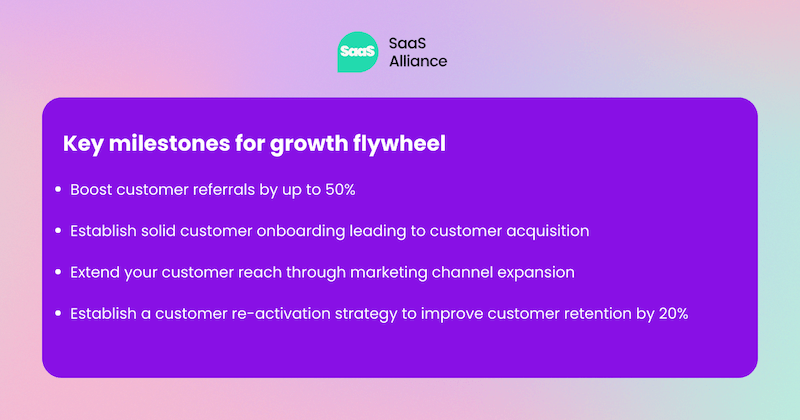
Establish strong collaboration between teams
Cross functional collaboration between teams is absolutely essential for SaaS success. No successful SaaS organization has its teams working in silos, each team has to be mindful of how their own individual OKRs contribute to the larger OKRs of the organization. A SaaS organization is like a well-oiled machine, and with the implementation of this OKR you can ensure that each individual department of your company works in sync.
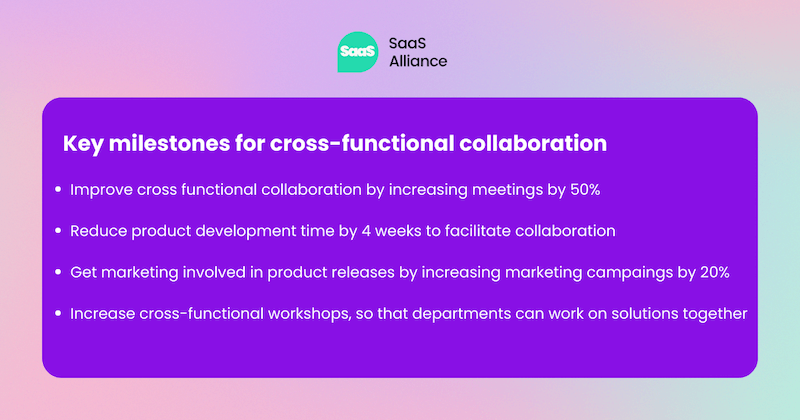
Make customers into advocates
One of the best ways SaaS startups can both improve acquisition and strengthen retention is through customer advocacy. In today’s user-centric climate, users are very savvy to traditional marketing tactics, and the best way to showcase the real benefits of your product or service is by showcasing the successes of those loyal customers.
And it goes without saying that startups who are looking to grow sustainably, customer ambassadors are a relatively affordable tool for convincing prospective customers of your product’s value.
Equally, ambassadors can act as a support for new users who are in danger of churning. They can help guide customers to the all important value moment that will make them “stick’ to your product.
Here are the milestones you should be looking at to achieve this OKR:
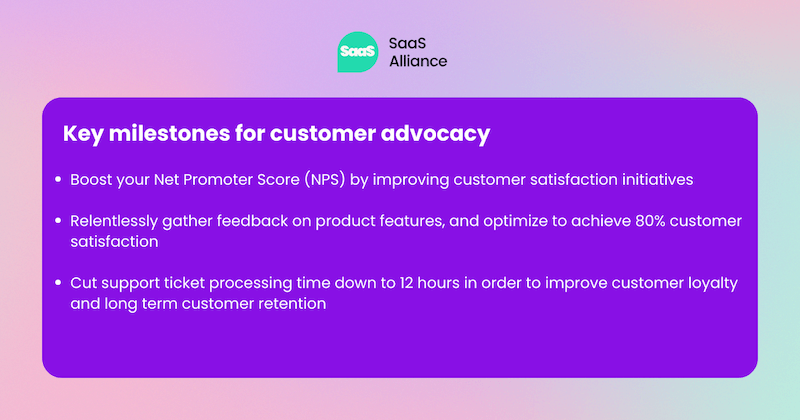
Creating an inbound marketing strategy
Inbound marketing can give SaaS companies a serious boost, mostly because it’s super cost-effective and really fits well with the digital nature of their products. Using SEO, social media, and content creation draws in customers naturally, which is not just cheaper than traditional ads and cold calls but also perfect for subscription models where you want to keep customers around for the long haul.
Plus, as your SaaS company grows, your inbound marketing efforts can scale up too, without needing to spend much more.
Now let’s look at some of the smaller milestones you need to think about in order to have a strong inbound marketing strategy:
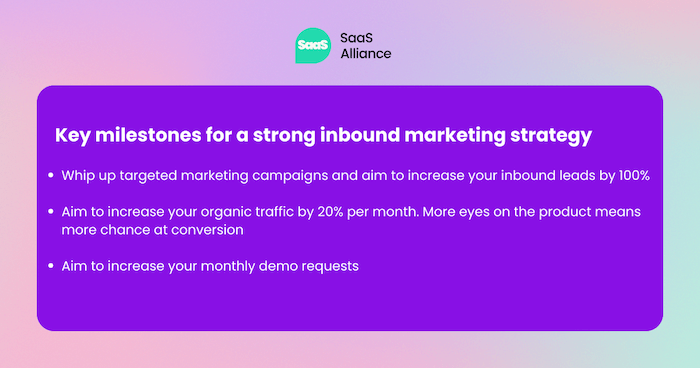
Creating a top notch customer experience with an amazing product
It’s no secret, with the global dominance of SaaS, the control is truly in the hands of the customer. Customers can pick up a new software solution and cancel at any time, so for that reason it’s important for SaaS orgs to demonstrate that their solution can solve user pain points, and that it’s going to make a significant impact on their day to day challenges.
But creating a top notch customer experience is no mean feat, so like with everything else you’ll want to break your ultimate goal into bitesize chunks. Let’s get into them here:
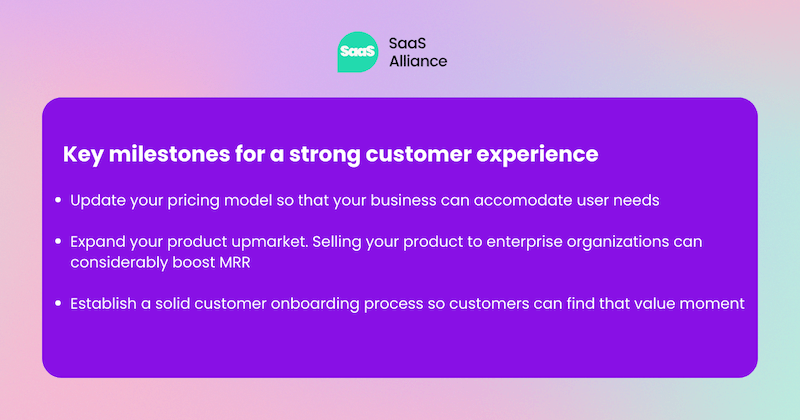
Increase Monthly Recurring Revenue (MRR)
For SaaS companies, growing monthly recurring revenue, or MRR, is vital—it's the financial backbone that keeps everything stable and predictable. This steady stream of income means companies can plan their finances better, make smarter long-term investments, and keep scaling up without sacrificing service quality.
Strong MRR isn't just about having enough cash; it shows that customers believe in the product and stick around, which is a huge plus when you're looking to attract investors or secure more funding.It’s a pretty overwhelming goal. Let’s see how you can break it down it into smaller milestones:
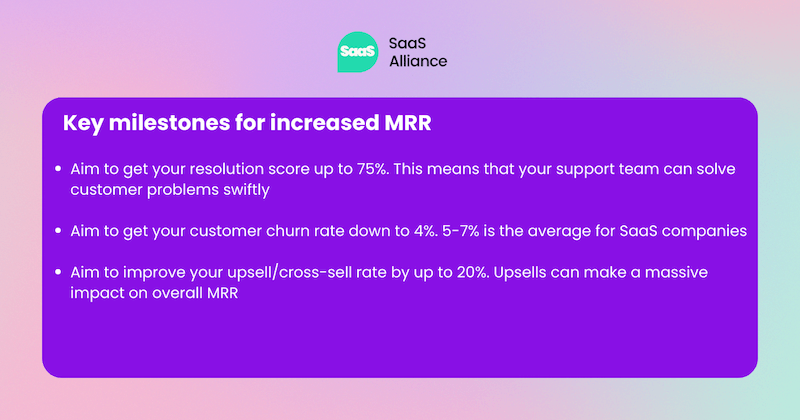
Utilize AI to increase your customer base
AI has shown enormous potential in enabling some of the giants of the industry to make a killing. From content creation and improved customer support, to detailed analysis, AI can allow SaaS companies to get ahead of the competition, grow rapidly and sustainably.
You may think that AI lacks that essential human touch to really resonate with your customers, but if used thoughtfully, AI can deal with necessary, but time-consuming tasks so that your creative maestros can have more time to tackle complex issues.
Here are some of the smaller, but significant goals you should bear in mind when introducing AI into your business:
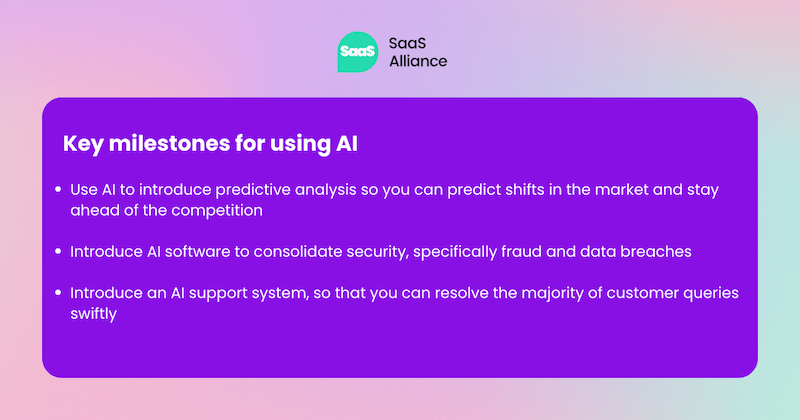
Build strategic partnerships
Building strategic partnerships can be a major boost for SaaS companies. It's not just about reaching new markets—though that’s a big part of it—it's about doing it efficiently by tapping into established brands that already have the trust and attention of the customers you want to reach. These collaborations can also beef up your product by integrating new features or tech, creating a richer solution that really resonates with users.
On top of that, partnerships are like a two-way street of benefits. You get to pool resources, share expertise, and even boost your own credibility by association.
Create a fantastic company culture
The culture within your company impacts their interactions with potential customers. Users can tell if you employees really believe in your company and product, and for that reason it’s essential that employees are proud to work for your company and really believe in what they’re selling. Smaller milestones may include the following:
- Reduce employee turnover to 10%
- Introduce company social events so that you can build strong rapport within your team
- Aim for an eNPS score of at least 50+ ( this metric measures employee satisfaction)
5 Best OKR examples by department
Here’s a few example OKRs to get you started, broken down by team.
Company-wide
Objective:
Increase our recurring revenue.
Key Results:
- Increase monthly recurring revenue (MRR)
- Increase sales by X% each week
- Increase retention rate to X%
- Reduce churn by X%
Customer Success
Objective:
Improve our customer satisfaction score
Key results:
- Exceed net promoter score (NPS) of over 7.0
- Get at least 1,00 responses to customer satisfaction survey
- Interview at least 30 of our top customers
Product management
Objective:
Launch new product successfully
Key results:
- Get X amount of sign ups
- Convert X amount of freemium users to premium
Development
Objective:
Stabilize product
Key result:
- Increase code unit test cover from X% to X%
- Reduce bugs reported after initial release from X to X average.
- Increase unit test coverage by X%
Marketing
Objective:
Distribute content effectively
Key result:
- Publish a guest post on X blog
- Improve backlinks by X%
- Acquire X more followers on socials
Conclusion
As we said a little further up the article, there’s no one size fits, but if you follow our advice and tweak it to your team's individual circumstances you can’t go far wrong.
Having quarterly updates for product, sales, and marketing leadership helps to establish trust and credibility and leads to a real sense of ownership and belonging as you work together towards shared goals.
Like what you see? For exclusive insights from the mightiest minds in SaaS, why not become a member?




